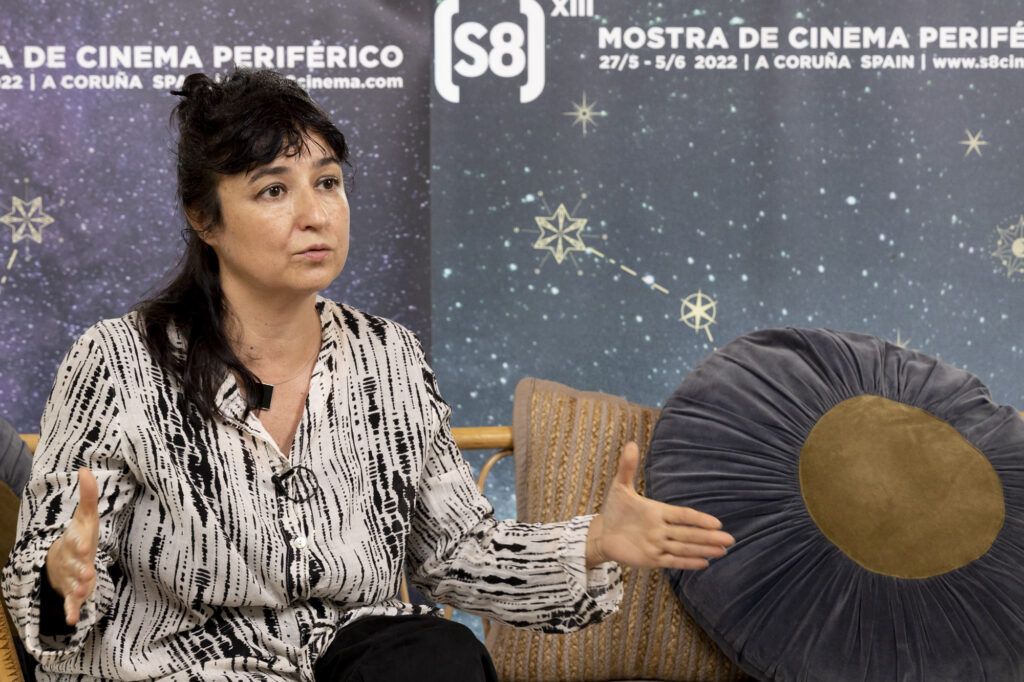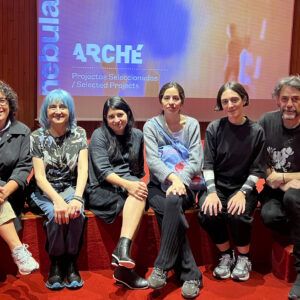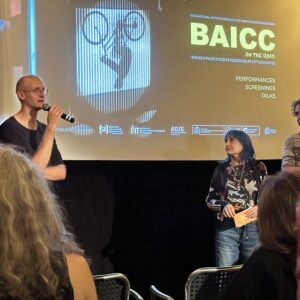
I understand that you come from the sphere of photography. How did you start working with cinema?
Deneb Martos: At the laboratory where I work at La Casa Encendida I’ve always done a lot of research into the medium, with the darkroom and the photosensitive medium itself. In the Casa Encendida there was a workshop called Cine Bastardo, which was given by Gonzalo de Pedro and Antoni Pinent. Back then I was doing tests on photographic paper of stills with textures, projecting leaves and insects that I gathered from nature. I had bought orthochromatic film and during that workshop it occurred to me to do a test with those same bugs that I was using to take still photographs. I put them very intuitively into that film and then, when viewing things in the workshop, it was projected, but then that stayed there on standby. Then I met Alberto Cabrera in another of his workshops. It so happened that I was also studying jewellery and working with gold leaf on wood, and during the workshop I took a piece of transparent celluloid home to put the gold leaf on it. The next day we saw it projected and I was totally amazed, so I continued investigating. Alberto also encouraged me; he left me his projectors and the splicer for when I needed to do tests, and we would watch them. I made the first 16mm film I worked with, which was also Gold Film, in 2014. I later showed that first film in an activity with José María Sánchez Verdú, who is a Spanish musician who works a lot in Germany, and our paths crossed working in different disciplines concerning what’s on the other side of the image. He suggested collaborating together in an event called Alegorías de la Luz (Allegories of Light) and we worked there. I spent almost a year researching different materials in search of certain textures and colours for that piece that we took to the Akademie der Künste in Berlin in 2017. Then I continued investigating until reaching where we have arrived now.
The mise-en-scène for all of this is very sophisticated; you not only show the projected film but also what the filmstrip itself looks like. How did you end up displaying it like this?
Deneb Martos: On having the 16mm film as an object and projecting it, I realised that I needed something else, because when it’s being projected we only see one side. They would tell you that it was a golden film, but then all of those ideas that are behind it like the projection devices themselves, the work in the darkness of the room, behind the projector, didn’t get seen. The matter of time, of movement, the fact that it is film in gold, also places great emphasis on what celluloid itself is, as a medium. It has that side of a tribute to the film as a skin, as a layer, as a material with a life of its own. This film was the main proposal to take to the Akademie der Künste and I was very aware that 16mm was a small format for a space like the one we had to bring to life. That was added to the fact that I come from working with celluloid for still photography, which is 35mm, the format I am familiar with and which I have a greater manual relationship with. It was also combined with the fact that I was very aware that we were working in a very large space, and that in order to have that almost human scale of the viewers themselves, for them to also penetrate the installation itself, the film required a loop and also called for being seen as something with the nature of an installation. So I got in touch with projectionists. Daniel Pérez, from the Filmoteca, helped me a lot as an adviser, as did Álvaro Ogalla in order to see what the machine was going to demand of me for that live performance, because in the end I get inside the machine when the performance is happening. So I had to generate this kind of invention, a machine loop, which is not like the one you normally see in other installations. It’s really a very simple machine, where the entire film can complete that path. Its scale is designed for the size of the projection screen, and the size of a human being. Then I set up my workspace with a table and a pulley system to be able to intervene live on film without really destabilising that system.
That same machine also generates a kind of sculpture in space…
Deneb Martos: Yes, it was like that from the outset. I went to visit the space where it was going to be premiered in Berlin, which was a very large hall. In the early arrangements I did, it was about generating a cavern with two circuits, which turned out to be much more complicated. For reasons of money I didn’t continue with my efforts to do it that way, and in truth I realised that it wasn’t necessary, either. It could also be generated by the illusion of that first celluloid wall and its shadow. All of this sculptural side works with the static film, and it’s beautiful, but in the moment the machine works it’s like an animal, a bug, and it has all that strength of analogue things, of sound, of an engine, and then that rain of gold, of that movement we can play with that opens up a great many possibilities.
That also has one more dimension, which is the lighting itself on the film strips and the video camera that picks them up and projects them.
Deneb Martos: In analogue cinema we have the machine that makes it possible to see the image we have trapped on celluloid, which again has a scale when projected, and it works because light passes through the matter. But gold, due to its physical qualities, is opaque to light. Gold shines because it reflects light, but light cannot pass through it; it casts its shadow and thus generates this contradiction. I was very interested in emphasising these qualities of gold, which on a symbolic level has all these connotations, both positive and negative, and highlighting these other physical qualities of gold and light, because we see things thanks to the reflection of light: if the objects in the world did not have the ability to reflect that light, we wouldn’t see them. In order to see gold, you need to illuminate the entire piece with a curtain of light so that it can be seen within the darkness of the hall and the viewer can move within that space. Then, by introducing the digital device, I emphasise that characteristic of seeing the film by reflection. That also allows me to play with other rhythms in the movement. In analogue terms I have kept 24 frames per second, but the digital side is a continuum. I work by intervening in the film that the digital device is projecting. I like to highlight the qualities that both processes have and how they complement each other, rather than contrasting them with one another.
As regards the sound, what is your work with Wade Matthews like?
Deneb Martos: That was as a result of being invited to activate the piece at FilMadrid, where they gave me the chance to work with him as a “dance partner” and we immediately connected very well. Wade understood right away what I wanted, which was to give the machine its full dimension as a living animal. He was able to bring out all the sounds and rhythms the machine has, which if not go very unnoticed or end up blending in with the sound completely.
Wade is an improviser: his way of working with sound is to record and capture certain sounds that the structure itself and the mechanism itself both have, and then put them into his instrument, his computer, which he has customised a great deal. We have both already done rehearsals and have certain guidelines; we know how we breathe and when everything is live it flows smoothly.





